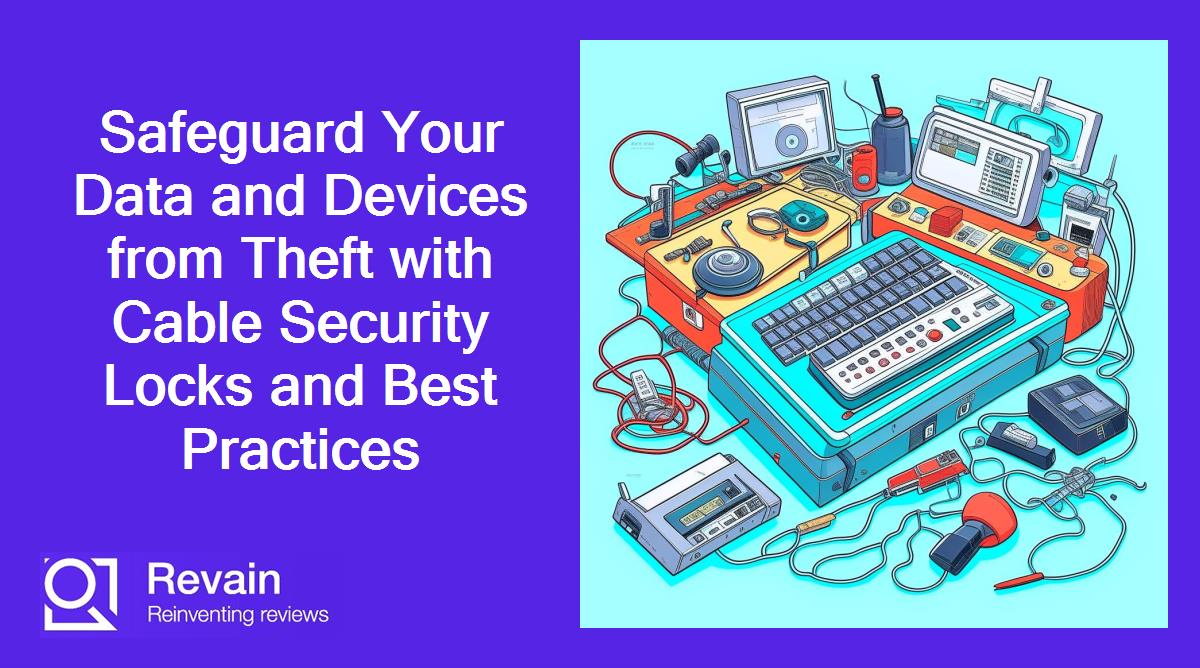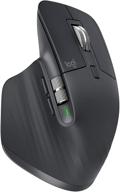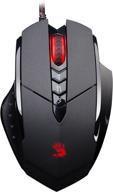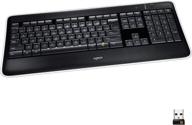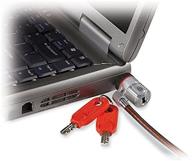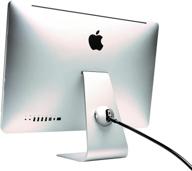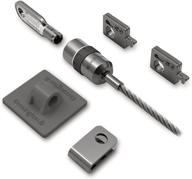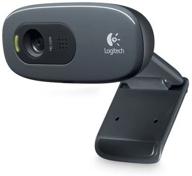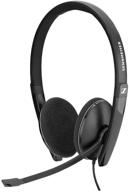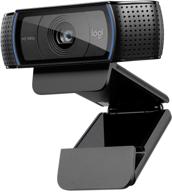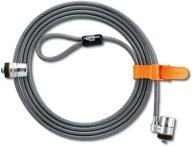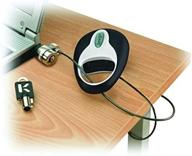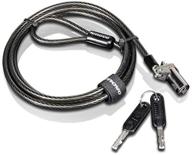Similar products
Protect Your Devices from Theft
In today's world, our laptops, tablets, and phones contain huge amounts of personal and confidential data. Losing devices to thieves can lead to identity theft, privacy violations, and lost productivity. That's why it's critical to take precautions against grab-and-run thefts of your electronics.
Use Cable Locks to Secure Laptops and Tablets
Cable locks provide an effective deterrent against quick thefts in public areas like coffee shops, airports, libraries, etc. They attach to a Kensington security slot found on most laptops, tablets, and phones. Here are some benefits of using cable locks:
- Prevent thieves from snatching your device and running
- Discourage smash-and-grab break-ins of vehicles
- Provide peace of mind when briefly stepping away from your device
Consider these factors when purchasing a cable lock:
| Lock Type | Features |
|---|---|
| Keyed | Uses physical key to lock/unlock |
| Combination | Unlocks with dial combination code |
| Fingerprint | Unlocks with registered fingerprint |
Secure Desktop Computers and External Drives
Cable locks aren't just for portable devices. You can also use them to protect desktop computers, external hard drives, and other devices with security slots, even in your home or office. This helps guard against:
- Employees stealing data or equipment
- Break-ins where thieves target computer equipment
- Opportunistic thieves in the workplace
Locking computers and external drives is quick and inexpensive. It adds an extra layer of physical security for sensitive data and equipment.
Safeguard Your Devices While Charging
Public USB charging stations pose a theft and data hacking risk. Thieves can steal locked devices by unplugging the chargers. And hacked charging stations can transfer malware to your device or spy on data flows.
Using a cable lock while charging protects against both threats. The lock prevents disconnecting the charger. And the data pin on most security slots is blocked when a lock is inserted. This closes a key malware entry point.
So don't take chances while recharging devices where strangers have physical access. Use cable locks consistently for total security.
Top products in 🔒 Cable Security Devices
Choose a Quality Lock
A cheap, flimsy cable lock can often be snapped with enough brute force. Invest in a tougher lock made with cut-resistant steel cable. The level of locking strength you need depends on the device value and risks in your specific environment. But don't skimp on the quality to save a few dollars.
By taking sensible precautions with high-quality cable locks, you can dramatically reduce your chances of becoming an electronics theft victim. Do your homework, find the right lock, and make it a habit to use it whenever your devices leave your hands, even if only for a minute. Consistent cable lock use is the key to effective theft prevention in today's world.
How Cable Locks Can Secure Laptops, Tablets, and Other Devices
Cable locks provide a simple yet effective way to secure portable electronics that have a lock slot. This article explains how they work, features to look for, and best practices to get the most protection.
What Are Cable Locks?
A cable lock is a flexible metal cable with a loop at one end and a locking mechanism at the other. The lock attaches to a security slot found on most laptops, tablets, and some phones and accessories. Cable locks come in various lengths, materials, and lock types:
- Keyed - Unlock with a physical key
- Combination - Dial in a numeric code to unlock
- Fingerprint - Unlock with your fingerprint
Securing Laptops and Tablets
Laptops and tablets are prime targets for quick smash-and-grab thefts. A cable lock creates an obvious, preventive barrier:
- Loop your lock through a cafe table or chair
- Lock your laptop bag zippers together
- Secure a laptop to a desk or fixture
This buys time and attracts attention if someone tries stealing your device. For extra security, lock laptops inside carrying cases.
Another interesting products
Locking Down Desktop Computers
While less portable, desktops also benefit from cable locks to prevent:
- Employees stealing towers or monitors
- Hard drive thefts containing sensitive data
- Opportunistic home burglaries when residents are out
Lock down computers, screens, and external hard drives to create another barrier for would-be thieves.
Securing Devices While Charging
Public USB charging stations are prime targets for thieves who swipe locked devices by unplugging them. And “juice-jacking” attacks can transfer malware from hacked charging stations.
Locking into the security slot while charging protects against both threats. This should become standard practice when recharging on the go.
Choosing an Effective Cable Lock
With so much at stake, it’s worth investing in a high-quality cable lock made with cut-resistant steel. Key features to look for include:
| Feature | Benefits |
| Tough steel cable | Resists hand and tool attacks |
| 6+ ft. cable length | More flexible locking options |
| PVC coating | Prevents device scratches |
| Lifetime warranty | Covers cut cables, lock failures |
Avoid cheap, thin cable locks that can be easily cut. Investing in a high-quality, cut-proof lock gives total peace of mind.
Using Cable Locks Effectively
Follow these tips to get the most protection from your cable lock:
- Lock devices whenever unattended, even briefly
- Secure to immovable objects like pipes or desks
- Keep keys and combos protected
- Register devices with tracking software
- Lock laptop bags zippers together
Consistently using quality cable locks, at home and on the go, is your best defense against device theft. Don't become an easy target - take steps to protect your valuable electronics.
Foiling Grab-and-Run Thieves in Public Spaces
Coffee shops, airports, libraries, and other public venues are prime hunting grounds for thieves who grab unattended devices and run. Luckily, there are steps you can take to avoid becoming a victim of these brazen crimes.
Understand the Risk
Grab-and-run thefts often share these traits:
- Targets are devices left unattended, even briefly
- Thieves look for easy, opportunistic scores
- The aim is to grab and flee before being caught
Laptops, phones, and tablets are frequent targets. But any portable device of value may be at risk.
Use Cable Locks
A cable lock anchored to an immovable object can foil quick thefts. It adds precious time to secure the lock, which:
- Allows people to notice the attempted theft
- Makes it hard for thieves to detach locked devices
- Creates opportunity for intervention
For best results, thread locks through bags or fixtures so devices can't simply be unplugged and stolen.
Lock It Down Tight
| Location | Security Tips |
| Coffee Shops | - Lock devices to tables or chairs - Sit where you can watch your items |
| Airports | - Lock down at gates and charging stations - Lock devices inside bags |
| Libraries | - Secure laptops to study carrels - Lock bag zippers together |
Other Precautions
Practice these habits to boost security in public venues:
- Log out of accounts when stepping away
- Back up data regularly in case of theft
- Enable tracking software to help locate lost devices
- Keep smartphone tracking activated
- Install security apps that photograph thieves
- Insure expensive electronics
Stay Vigilant
Help deter thieves by:
- Not leaving devices unattended for long
- Choosing seats with visibility on your items
- Being alert to suspicious activity around your belongings
- Not displaying expensive electronics openly
With the right combination of cable locks and caution, you can stay safe from grab-and-run thieves looking for an easy score in public venues.
Don't become a victim! Take sensible precautions to protect your belongings and data when out and about with your devices.
Stop Unauthorized Access to Your Data
Our devices contain massive amounts of personal and company data. Unauthorized access puts users and organizations at risk of privacy violations, identity theft, and loss of confidential information. Luckily, there are steps you can take to lock down your data.
The Threat Landscape
Data threats typically involve:
- Hackers trying to breach devices
- Thieves stealing unlocked equipment
- Unsecured devices being lost or left behind
- Insider data theft by employees
Laptops and company servers with customer data are frequent targets. But any device loss can compromise personal information.
Physical Security Measures
Physical barriers to accessing devices can thwart many data threats:
- Cable locks - Secure devices, desktops, servers
- Encrypted drives - Render data unreadable if stolen
- Locked server racks - Protect central data stores
- ID access controls - Restrict data center entry
These measures create layers of security to block unauthorized physical access to devices and data.
Securing Company Networks
Technical controls also help defend company networks and data:
- Firewalls to prevent outside access
- Employee access permissions
- VPN connections for remote workers
- Intrusion detection systems
- Data encryption
IT experts must implement robust cybersecurity defenses along with physical protections.
Safeguarding Your Personal Data
For personal devices, focus on these best practices:
- Strong passwords and passcodes
- Two-factor authentication
- Minimal sensitive data storage on devices
- Regular data backups to the cloud
- Drive encryption
- Password managers to store credentials
No single tactic is perfect, but combining several techniques goes a long way towards securing your personal data.
Responding to Data Breaches
If a data breach does occur:
- Alert appropriate IT staff or cybersecurity teams
- Request an analysis of compromised data
- Reset all account passwords impacted
- Notify affected customers per regulations
- Review security protocols to prevent recurrence
Taking prompt, methodical action limits damage from breaches. But prevention is far easier than reacting to unauthorized data access after the fact.
Vigilance Pays Off
With persistent threats from many angles, protecting your data requires ongoing vigilance. But consistently following sound security practices makes it very tough for anyone to access your information without authorization.
Don't let your devices become easy targets. Take control of your data's safety with comprehensive physical, technical, and operational safeguards.
Using Cable Locks to Prevent Data Theft
Laptops, hard drives, and other devices contain sensitive data that's invaluable to both individuals and organizations. Physical cable locks provide simple yet effective protection against device theft that could lead to compromised data.
The Role of Cable Locks
Cable locks:
- Deter smash-and-grab thefts of devices
- Prevent unauthorized unplugging/removal
- Increase the time/difficulty of stealing locked devices
Key Devices to Lock Down
Locking these devices protects against data theft:
- Laptops - Contain emails, documents, credentials
- External drives - Store sensitive backups and archives
- Desktop towers - House data on internal drives
- Servers - Data centers for entire organizations
Don't overlook any device holding confidential personal or company data.
Locking Down Laptops
Portable laptops are prime targets for theft. Follow these laptop locking tips:
- Secure to immovable fixtures like pipes or desks
- Lock inside carrying cases for added protection
- Loop cables through backpack straps or zippers
- Lock computers even when briefly stepping away
Consistently using cable locks while mobile protects invaluable data if theft is attempted.
Locking External Hard Drives
External drives often contain sensitive backups, archives, or working files. Safeguard these drives by:
- Locking down drives when not actively being accessed
- Storing in locked drawers or cabinets when not in use
- Using shorter cable locks to secure to desktop computers
This inhibits drive theft both in and out of the office.
Securing Servers and Desktops
While not portable, desktop towers and servers still benefit from cabling up. This provides protection against:
- Disgruntled employees trying to steal data or equipment
- Office burglaries targeting computer equipment
Even non-mobile devices are at risk without cable locks.
Choose High-Quality Locks
A cheap, weak lock can often be cut by thieves. Invest in tougher locks made with cut-resistant steel. Good locks deter thieves from even attempting to steal locked devices in the first place.
Securing your organization's data requires being proactive about physical barriers like cable locks. Don't wait for an incident to take sensible precautions.
Securing Desktop Computers, External Hard Drives, Etc.
While less portable than laptops and mobile devices, desktop computers and external hard drives still require physical security precautions. The sensitive data stored on these devices can be compromised in equipment thefts and lead to consequences like identity theft or confidentiality breaches.
Threat Scenarios
Data loss risks for desktop equipment include:
- Office burglaries targeting computer hardware
- Insider theft by disgruntled employees
- Hard drive removals containing sensitive information
- Opportunistic small-scale thefts of devices
Company desktops with customer data and external drives with backups need protection.
Physical Security Fundamentals
Start with these basic physical security measures:
- Position desks and computers away from windows when possible
- Only give access keys and alarm codes to authorized staff
- Lock desktop towers inside desks or cabinets when not in use
- Secure external drives in locked drawers when unattended
This establishes baseline controls against unauthorized device access.
Securing Desktop Computers
To further lock down desktop towers, use:
- Cable locks - Attach computers to desks using security slots
- Tower locks - Special locks to secure tower side panels
- Desktop alarms - Motion-activated alarms for off-hours
Monitoring and limiting computer tower access is key.
Safeguarding External Drives
For external hard drives, extra protections include:
- Locking drives in desk drawers or cabinets
- Cable locks to secure drives when unattended
- Encryption to make data unreadable if stolen
- Backups to cloud or off-site so theft has minimal impact
This robustly protects from data loss due to drive theft.
Deter Insider Threats
Trusted employees with malicious aims present unique risks. Safeguards against insider theft include:
- Access controls for sensitive info and locations
- Monitoring logs for unauthorized activity
- Requiring ID badges to access data centers
- Protocols for promptly disabling access when employees depart
Vigilance is essential even with trusted staff. Integrating multiple physical, technical, and operational controls creates layered security against data theft or misuse.
What Are The Most Common Problems Faced By Users Of Cable Security Devices??
Based on the search results, here are some of the most common problems faced by users of cable security devices:
- Using the wrong cable type
- Not using plenum rated cables in a plenum ceiling
- Improper wiring techniques
- Not keeping the low-voltage wires separate from high-voltage electrical wires
- Inadequate cable length
- Improperly sealed outdoor connections
- Cabling being put under constant stress by bending, abrasion within cable structure, or conductor strand breakage
- Electromagnetic susceptibility causing interference with cabling and physical security cameras
- Animals damaging cables
- Network cables not ideally situated in places inconvenient for others or disruptive
- Imperfect installation or incorrect configuration
It is important to address these issues to ensure that cable security devices function properly and provide the necessary protection for your devices.
22 Gauge 6 Conductor Shielded Cables
22 Gauge 6 conductor shielded cables are commonly used in security, alarm, access control, sound, and intercom systems. They are designed to provide reliable and secure connections between devices. Here are some features of 22 Gauge 6 conductor shielded cables based on the search results:
Overall, 22 Gauge 6 conductor shielded cables are a reliable and secure choice for connecting devices in security and low power applications.






